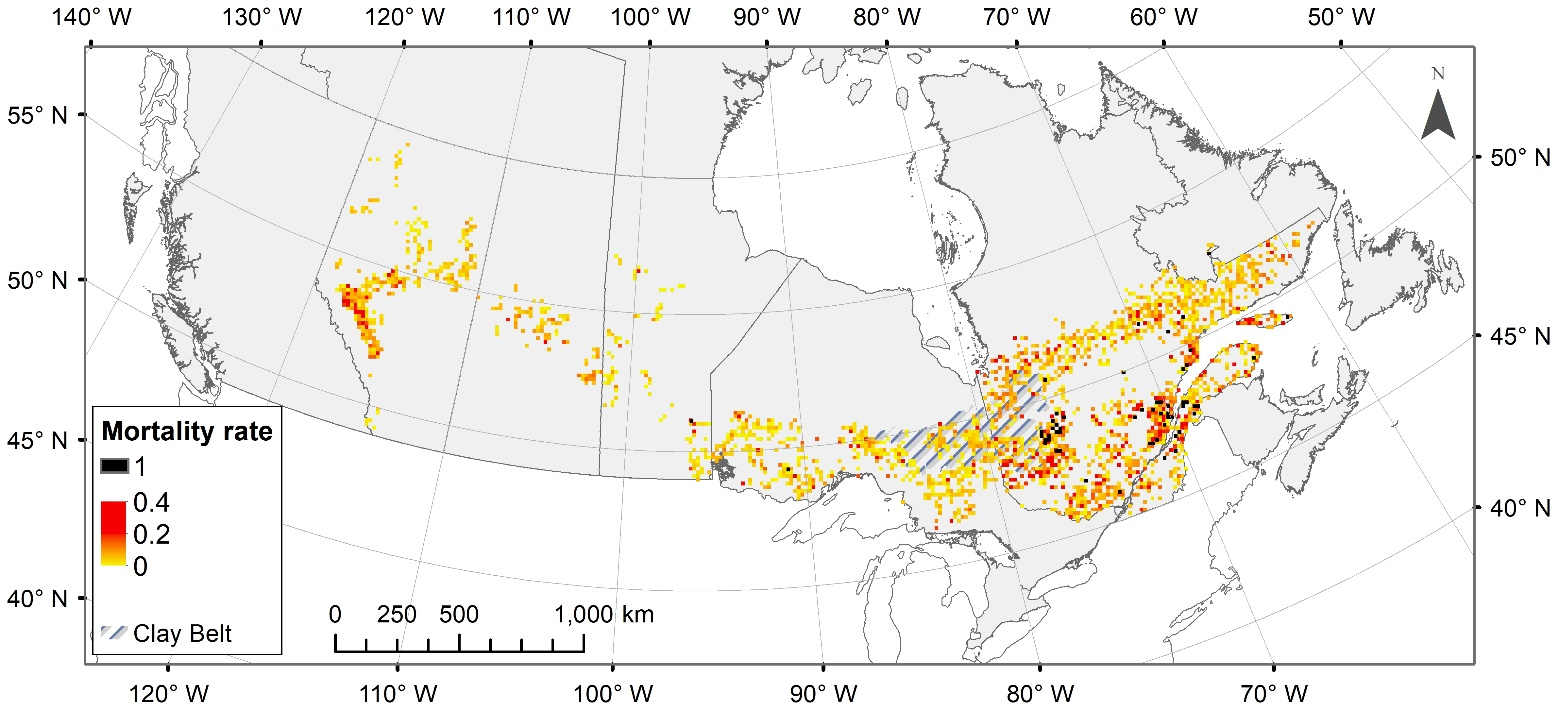Adapting Forests to Climate Change: Evaluating Forest Responses and Mitigation Scenarios to Multiple Stresses
Chronic multiple repeat events of low amplitude may cause more long-term losses than punctual severe disturbances yet are easier to ignore. Forest industry and governments must prepare for the combined effects of long term effects.
Project details
Principal(s) investigator(s)

Context
As major changes are occurring in climate and the ranges of different pest species, it is imperative to evaluate their combined contribution to regional tree mortality and growth reductions to assess species vulnerabilities, and to propose optimal mitigation measures to maintain forest productivity and ecosystem services.
It is also imperative to identify environmental factors and stand characteristics that render trees more vulnerable and to prioritize management interventions. As climate changes and stresses and their interactions increase, it will be critical to assemble a team of researchers and end-users throughout Canada to establish efficient and operationally viable actions.
Objective(s)
-
Identify the most efficient adaptation actions to reduce forest productivity losses resulting from interacting biotic and climatic stresses on tree and stand mortality and to identify strategies and forests where potential gains in productivity could be made;
-
Initiate the establishment of a long-term, Pan-Canadian network of regional research collaborators.
Methodology
- Collect and compile long-term forest inventory plot data from across Québec to Alberta ;
- Collect and compile growth data from eastern and western Canada as well as SBW and FTC defoliation data ;
- Analyse data sets, develop statistical models (including a new Bayesian approach);
- Begin installing monitoring stations across the country to monitor sap flow, growth phenology (both radial and bud burst leaf-out and development, soil processes, temperature) ;
- Organise regional workshop on climate change adaptation.
Results
From the growth data, we observed persistent negative tree growth responses to past water stress (drought) and defoliation in host trees (trembling aspen for forest tent caterpillar and balsam fir and spruces for spruce budworm) lasting 3-6 and 10-12 years, respectively, depending on study region (west vs east).
Our study results suggest negative feedbacks in tree responses to drought and insect attack may be weaker than predicted for defoliator-dominated boreal forest systems. Instead, insect defoliation may offset the impacts of water deficit on boreal tree growth by reducing transpirational water demand. This offset mimics increased resistance to drought following forest thinning and may lessen growth and mortality losses due to increased aridity and more severe insect damage forecast for the boreal forest under global change.

Figure1. Spatial distribution of forest mortality rate across the study area.
Our results from the long-term forest inventory plots, showed that the frequency of low-intensity droughts had stronger effects on forest mortality than the intensity of the most severe drought. Overall, forests dominated by shade-tolerant conifers had the highest mortality rates, with non-linear trends leading to threshold in mortality due to drought frequency. In mixtures with broadleaf species, however, sequential droughts had a negligible impact. Multiple repeat droughts in forests dominated by shade-intolerant species led to higher mortality rates on the wettest sites.
Our results highlight the importance of site specific assessments of climate change across different temporal scales. Over the long term, the smooth response of forests to sequential droughts could abruptly change beyond a given threshold leading to disproportional mortality triggered by accumulated stress conditions.
The long-term pan-canadian monitoring network that we have and are establishing will help to better understand trends and climate based mechanisms affecting tree growth and thus predisposing trees to mortality. This network will also serve as an early warning signal of forest vulnerabilities to stress events.
Benefits for Adaptation
Forest industry and governments must prepare for the combined effects of long term effects.
High mortality following drought on wet sites also shows that greater understanding of responses is needed to ensure proper site specific treatments.
Scientific publications
Funding

Other participants
-
Canadian Forest Services
-
Université TÉLUQ
-
MFFP
-
University of Alberta
-
UQAT
-
FP Innovations